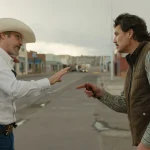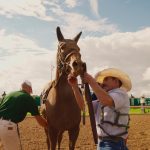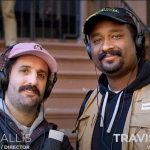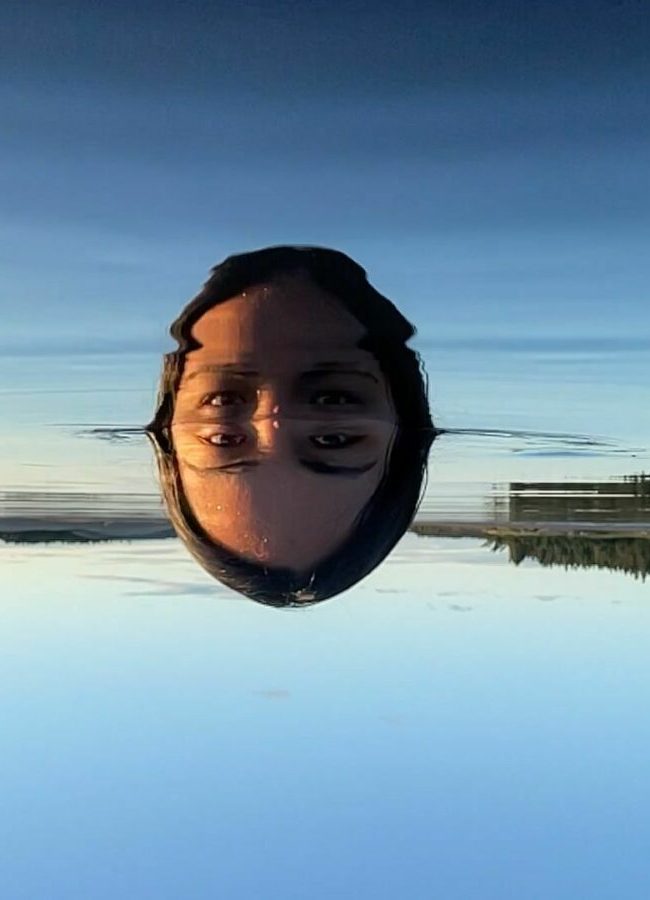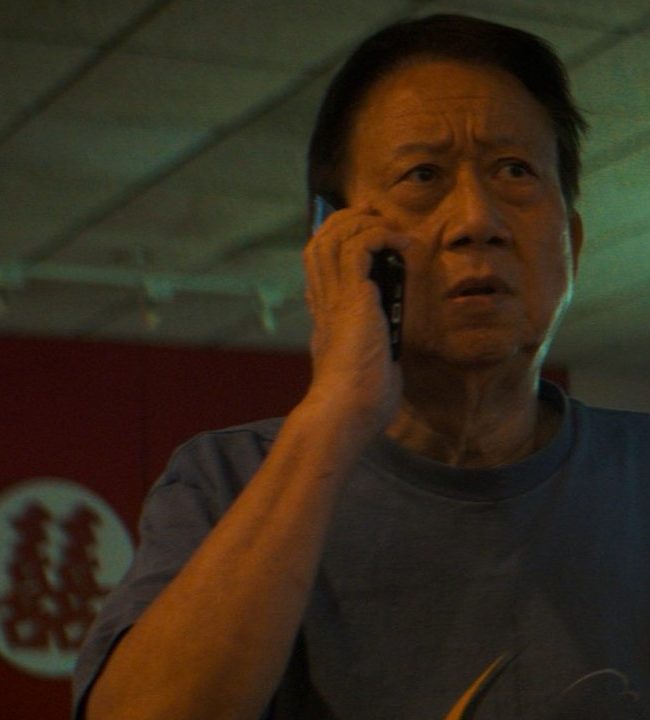A Conversation with Kimi Takesue (ONLOOKERS)
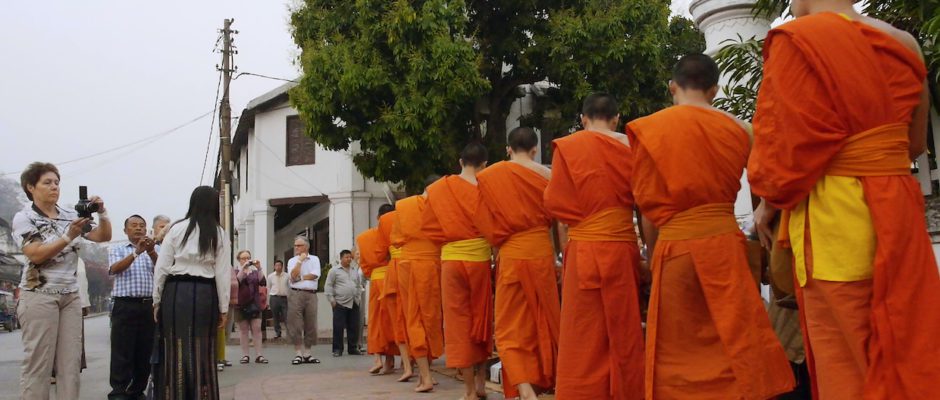
“This is what documentary filmmaking can be at its best: an opportunity to have rich life experiences, to wander and reflect, to visit new places, to embrace spontaneous encounters. For me, the pleasure of documentary filmmaking is that it is unscripted and exploratory. Once I impose expectations and agenda onto the process, it loses something essential.” – [Kimi Takesue essay] Seeing and Seeking, Talkhouse.
For astute audiences, seeing the names of Karin Chien and Sarah Archambault associated with any project should be sufficient to encourage an immediate seeking-out. In the instance of Onlookers, admittedly, there are few other names to be found in its credits. Nearly all of the roles associated with the making of the film are occupied by the filmmaker (who, by this point, has similarly established an immediate expectations of worthiness with anything to which her name is attached). A veritable one-person film-crew, Onlookers was directed, produced, photographed, sound-recorded and edited by Kimi Takesue although, given the exquisite care to the picture and audio, understandably adds a handful of post-production individuals for color and sound-mixing and -editing.
Previous feature-length documentaries Where Are You Taking Me? (2010) and 95 and 6 to Go (2016), filmed in Uganda and Hawai’i, respectively, have already established her abilities to transcend easy classification. These works were interspersed with a number of celebrated short films such as Heaven’s Crossroads (2002) [Vietnam], Looking for Adventure (2013) [Peru] and others—non-fiction and narrative alike—completed closer-to-home in New York, not far from Takesue’s role as Professor in the Department of Arts, Culture and Media at Rutgers University in Newark and a mere 250-ish kilometers from her hometown (one-of-two) in Amherst, Massachusetts.
Onlookers debuted last year around this time in Park City at Slamdance (where Heaven’s Crossroad premiered two decades earlier). Its European premiere occurred at the legendary Cinéma du Réel in March followed by its initial New York screening, appropriately enough, at Prismatic Ground last May. Its theatrical bearth at the Metrograph marks an all-too-rare yet deserved achievement for an independently-produced documentary of quiet contemplation.
Who, you might ask, are the Onlookers? In Laos, the sole landlocked country in Southeast Asia, bordered by Thailand to the west, Vietnam to the east, Camboda to the south(east) and China (along with Myanmar) to the north(west), the on-screen ‘lookers of Onlookers are tourists traipsing across historical sites, exquisitely framed in a stunning semi-tropical locale. They are also, in part, the citizens of this country, going about their daily lives while observing the many tourists who pass their way. Due to the placement of the camera, a triangulation of “onlookers” additionally consists of the audiences themselves, with tourists and locals very-much-aware that they are being seen and, accordingly, frequently return their gaze to the viewer.
Perhaps the more viable question is what are the Onlookers? What sort of film has Takesue made? It could be considered a travelogue although those, by design, would contain narration in a near-advertisement of the many merits of a country. Onlookers definitively has none of that. One could otherwise classify it as an ethnographic film except that the travelers are on-view as much as the population of the place. It could be, if necessary, grouped within the catch-all of “observational documentaries” wherein it shares some similarities. There are observations to be observed, undoubtedly, hence the title. Which is it? All-of-the-above and none-of-the-above, simultaneously.
What does Onlookers say about travel and traveling? The journey and the destination? About understanding ourselves and our efforts to understand others, elsewhere? There are nuanced answers to all of these points within the context of the film. Furthermore, there are illustrated answers ahead (in the truncated dialogue that follows):
Hammer to Nail: Welcome back from your recent travels [to Paris*]! How was the selection of films for the [Fire Over Water] Metrograph series proposed?
[*…more about that expedition below.]
Kimi Takesue: I had submitted my film to Inge de Leeuw, the head of programming at Metrograph, and she is the one that came up with this combination of films. It is quite an honor to be alongside those other filmmakers [around the themes of transcendence].
HtN: Thinking back to your earlier compellingly-layered projects, specifically Heaven’s Crossroads, when you visited Vietnam, and then subsequently a similar-ish film in Uganda [Where Are You Taking Me?], how do you decide where you would want to film and what you’d prefer to observe?
KT: Many of these projects emerge from the basic curiosity to travel to a particular place. I don’t necessarily have expectations that a film will emerge. I brought my camera to those places and I go without any kind of real agenda or expectation and I just see what unfolds. With Heaven’s Crossroad, I had always wanted to go to Vietnam. As a child, being a biracial—I have a Japanese-American father and a Caucasian mother—and living between Hawai’i and Massachusetts, I grew-up in these two places. When I was with my mother in Massachusetts, I was often mistaken for being Vietnamese. It was strange because perhaps they thought that I was adopted? I don’t know. Somewhere, in my unconscious, I was curious to travel there. I went in 1995 when tourism had just started opening a bit. I brought along a Hi8 camera and I filmed. That piece is quite different [from Onlookers]. I immersed myself with the culture there and met a lot of local people. I had almost no contact with tourists since there were not a lot of tourists traveling at that point. Heaven’s Crossroad is really different because there is a kind of intimacy and connection, even though it does bring up questions about how to look cross-culturally. T
The one in Uganda, Where Are You Taking Me?, was actually commissioned by the Rotterdam International Film Festival. Part of the initiative was inviting filmmakers who were capable of making films with very little money to go to these different countries that had less of a film infrastructure. In Africa, part of the objective was for these visiting filmmakers to research the local film-scene and to connect Rotterdam with some of the interesting talent there, commissioning local filmmakers to make work for Rotterdam as well. These projects were extremely low-budget! I think it was maybe 7,000 Euros. In 95 and Six to Go, that film is a portrait of my Japanese-American grandfather in Hawai’i but it is also about the process of trying to make a narrative feature-length film.
Surprisingly, my grandfather became interested in that story and started to invest all this energy and creatively into it, providing ideas for the script. The funding for that film never came together and it was really devastating. I’d spent six years of my life [on the project] and it was all together, creatively. Unfortunately, the producers just didn’t get the money together. It almost obliterated me! I nearly gave up completely with filmmaking. After the crash of this project, I tried to do something a little more independently. I was in Pusan when the whole economy collapsed in 2008 and I made the shift back to making these intimate, handmade works that I could control. I also went into teaching and, since then, I’ve been making these kinds of films where I basically do everything. It has been a kind of response to a complete trauma with filmmaking.
HtN: You see in the credits [for Onlookers] that you directed it, produced it, photographed it, did all the sound recording and edited the film.

Filmmaker Kimi Takesue
KT: Yes! When I got into teaching full-time, I am only able to do these things in my moments when I have some time. I felt this vindication because 95 and Six to Go kind of rose from the ashes of what felt like such a failure. That film was made later but what happened is that I made this small film called Suspended (2009), which was basically right after this devastation. I decided to make something small just for myself: a series of vignettes where there was this kind of connective thread with people in states of limbo and states of suspension, physically and emotionally, which was basically what I’d been in. It was sort of subconscious. Suspended was nine minutes and it went to Sundance and New Directors and Rotterdam. When I was in Rotterdam, that was when they’d commissioned me to do Where Are You Taking Me?, the project in Uganda. I was just eager to get out of this mode of mythologizing and talking ad nauseum about all these meetings that amounted to nothing. Each of these films are primarily about me regaining sight and the ability to see the world around me after being in a mode of tunnel vision. Which is kind of the majority of my life!
HtN: The life of everyone these days, seemingly.
KT: Through the act of travel, I reconnect with my ability to be present. That is what many of these films are about and, in the context of Uganda, they’d asked me, “What are you going to make this film about?” I said, “I have no idea! But I know that it is not going to be these images of horror and victimization and the sort of stereotypical images of what I’ve seen of Uganda. I know it will be something other than that.” The film is a series of poetic vignettes of everyday life. There is a section where I end up going to the school of survivors of the civil war but I had an unusual opportunity to go there. At first, I was very tentative about even including any of that.
However, it is such an important part of the history and the society there. I represent it differently because, basically, you see all of these young people at a school and you have no idea of their history. Just young people studying and engaging in school and activities and all of these different ways. Then you learn a bit about their history. That obviously had a tremendous impact but they’re not defined by it. In essence, all of my films are an act of reconnecting with the world around me.
Onlookers is a bit different because there is a kind of pulsation between intimacy and voyeurism., A kind of connecting and being a more distant observer. In some cases, I integrate more into the place. I have more contact with the locals. Onlookers is quite a detached gaze because I really was a tourist traveling on a classic tourist itinerary. While I had some interactions with the locals, many were a bit suspect or jaded about the tourists. In a sense, my gaze shifted more towards the tourists but I think you still see some degree of movement between (and connection to) the standard path.
HtN: It does strike me as unusual that the film gives semi-equal balance to the tourists themselves as well as the people and places of Laos that are being observed. Both are onlookers in this context, along with the audiences. The audience is complicit in a way of observing the travelers and the population. Laos, in many ways, opens itself up to that approach since the behaviors of its citizens have been exoticized for many years. I wager your choices in camera-placement emphasizes these points. The economy in Laos obviously is dependent upon tourism and yet the presence of tourists inevitably interferes with daily life. You see that in Hawai’i as well, of course. These identical issues persist in Peru or Uganda and wherever you have filmed and particularly, in my own experience, in Egypt and the islands of the South Pacific and elsewhere. This constant grappling with the complications of tourism and daily life.
KT: Absolutely. The film is so much about these kinds of chains of looking and the gaze that is shifting between different positions. Me looking at people who are looking at people who are looking back at me. Then, ultimately, you’re saying that the audience is complicit and made aware of their own actions. Looking and consumption. I think that, in terms of the framing, it is constructed in these static tableaus that are replicated. Almost the image of a postcard. I think that you see my own tendencies, at times, to exoticize these places. I can’t help but be struck by their beauty in different ways. But I am also trying to critique that act of looking as well.
As you say, cultural difference is always exoticized to some degree and, in the context of Laos, the signifiers of cultural difference are the monks. They’re interwoven in this film and one can’t help but be completely seduced by the beauty of their rituals and the color and the sounds. At the same time, there is this fetishizing and commodification that can happen in the ways in which cultures turned into spectacle. I don’t think that there is any easy answer to that, right?
HtN: Absolutely.
KT: I think that the film is really trying to raise questions and make the viewer aware of the complications that you mentioned. I think that you see these points of interruption and invasion that happen as tourists intersect with locals. But I also think that you see the ways in which people coexist and don’t [intersect at all]. There are many locals who are unaffectedly going through with their daily lives and routines, which is very much the case, coming from Hawai’i, where tourism is prevalent. On one hand, you really see its impact. On the other hand, people are just going on with their lives and are often not that impacted by it all. In Onlookers, I am trying to show the range of those experiences. I think one of the things I am very interested in is the kind of choreography of tourism and the movement and the ways in which people engage with places and architecture and spaces. You often see people coming into the frame and then exiting the frame. Sometimes you do see that kind of violation that is happening in the sense of people coming and consuming and photographing and then leaving. But I love these moments afterwards where you often see a kind of majesty of the temple or the mountain that has been invaded but still stands strong. You get a real sense of an enduring presence.
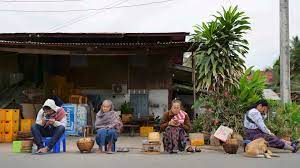
A still from ONLOOKERS
HtN: What I persistently found fascinating was your choice of putting yourself in the way of the movement of these tourists. They have to acknowledge what you’re doing because, in essence, you’re in their way. Generally, people will attempt to ignore the presence of a camera but you have eliminated that option. Most filmmakers would intentionally place themselves in a location to go largely unnoticed. When the tourists are arriving on a boat early in the film, for instance, you’re in such a position that the camera cannot be avoided which allows, for the viewer, the possibility of becoming immersed in the private and personal rituals of travel. While you cannot presuppose their intentions, you gain some awareness in their choices by what they’ve decided to bring along on their journey.
There is a subtext of briefly seeing travelers in a public place watching American television, for one example. A criticism, perhaps, of tourists wanting to bring aspects of home along with them rather than fully participating with their surroundings. They want a certain familiarity in a place otherwise new to them, not unlike the “cultural bubble” travelers tend to experience on a cruise ship or similar types of tourism. A sampling taste of the “other” without becoming fully a part of the destination.
What one gets from Onlookers is all of these layers of experience. Someone could write a thesis [or dissertation] on the very lovely sequence on the mountaintop alone, where these visitors appear more interested in taking pictures of themselves than the actual place (or, at least, “we are here” photographs documenting their visit to that location). It resonates in concentric circles out to everything that happens prior to this scene and everything that follows after that moment in the film.
KT: I hope that someone writes a thesis about it! First of all, I am definitely one of the tourists. I empathize and identify with all of the behaviors that represents. The spectrum of good intention and also awkwardness and ambivalence and exhaustion and, of course, intrusiveness. I am certainly guilty of all of those things as well. I think most people are! I really try to structure the film so that it is not an indictment in any way. I think you see a lot of the absurdity of human behavior and some of the humor. I hope it asks people to self-reflect. There is that sort of contradiction and there are existential questions raised about what people are seeking when they travel.
They want these authentic encounters with a new culture but many also want what is familiar and comfortable. Like you were saying, I certainly do not try to hide the camera. I am really interested in a kind of interplay and how people respond to me and that kind of interaction. You definitely see these little moments of engagement with me [and the camera]. Perhaps because I am a single person just shooting alone, I am relatively unobtrusive but I am certainly not trying to hide. There are no easy answers as to the correct way to travel.
HtN: I imagine that it is different for every traveler.
KT: There is a dependency that many of these places have on tourism and they were just devastated during the beginning of COVID. One’s presence and impact are important, of course, but it is only one layer of the film. Another is the act and experience of looking and being. These modes of deep-looking and deep-listening. Really noticing all of these brief moments that one could so easily overlook and understanding what they reveal about the human condition.
HtN: At what point did you involve Karin Chien and Sarah Archambault in the project?
KT: They are wonderful people and super producers. This is a completely no-budget project and it is challenging to assemble any kind of team because I don’t know what I am making until it is practically completed. It is a very intimate, quiet, intuitive experience. It is the opposite of what I was saying before about mythologizing. I don’t go in with expectation. I’m not raising grant money. I’m not talking about what something is [in-advance]. Once you have intent, it really does change everything and it changes the energy. It changes your relationship to what you’re seeing because, inevitably, there is a certain kind of aggression in the act of desire and want. “I want to get this” versus literally responding very intuitively and honestly to what is of interest and piquing your curiosity in the moment. These films, I think, have that quality and that is what makes them special. But what it means is that, even in the editing process, I am finding the film. It is not until I am done that I know what it is or that I want to talk to anyone about it. That makes it difficult to involve producers or a team until the end. I reached-out because I just have a lot of respect for both of them and they have some awareness of my work. They offered some support, which I really appreciated.
HtN: Many conventional documentaries lack the willingness to avoid preconceptions. They’re making a film “about something” and much of the material that they’re gathering is intended to support whatever premise that they’re supposedly making the film about. That is an immensely different type of approach and, I think, generally a less-rewarding type of filmmaking.
KT: That is what gets the funding, though! I do think that it is interesting that many equate value with money. The bigger, the better, you know? More people, more money, more crew, bigger cameras. I do think Onlookers is an example of what is particular and possible and specific through intimacy. This kind of film is only possible working in this very sort of small, quiet, intuitive way because, fundamentally, you just need to have patience. You need to not be on some sort of schedule or to be unobtrusive and blend into an environment to a certain degree. I have no schedule or anything. I have no particular plan. There is something in the act of filmmaking that is a certain meditation. That is why I particularly enjoy it.
HtN: It is great to see that you continue to make shorter pieces in-between feature-length work. You’re still exploring different pathways, whether it be narrative or documentary or some hybrid of the two. Have there been places where you have traveled and filmed when there just wasn’t something that came from it? Has there been a moment when you’ve filmed something and decided to put it aside?
KT: I just recently went to Indonesia to an amazing film festival [Festival Film Dokumenter]. I think, again, my reward in much of the filmmaking is getting the opportunity to travel and to share the work with different kinds of audiences. The festival was in Java [in the city of Yogyakarta] and I visited Bali. I did bring a camera. I hadn’t shot anything for a long time but I really was not inspired to film there. It was a combination of things. I was with a traveling partner and I have to just be in a completely different zone. I have to just be alone and not feel any of the sort of needs and pressures or wants of someone else. It is just a very private experience. Like in the context of tourism, I just didn’t really find anything in that particular place that was interesting to me to film. This kind of filmmaking is also incredibly demanding, physically, and I do question what the future is for me in that regard. Carrying all my equipment and schlepping around is really difficult.
As I get older, it becomes more challenging. This form of filmmaking, in some ways, is kind of responding to what unfolds and looking at the poetry of everyday life. It can become its own routine, too. I can start to do it and it feels like I am actually falling into a certain routine. I think, to some degree, every project is a response to what you’ve done before and trying to do something that is new and challenging in a different way. As an alternative, I have a series of video-portraits of people who work in the Laotian tourist industry. These are long takes of just me and the person engaged in an exchange of looking. They’re quite complicated shots. There is a lot of questions around power and representation but they’re also just really interesting individual portraits of people. In a sense, that was a response to being sort of distant, far away, by actually engaging with someone more directly, Asking, “Can I take your portrait?” I don’t really do much fiction anymore but I see the connective thread, thematically, with a real interest in visual storytelling. There are a lot of difference between my films. It is hard to completely categorize me and it is quite hard, professionally, because one programmer will like the experimental side of your work but they won’t necessarily like the other side. It is hard to gain a certain momentum because that is how many artists get branded. I hope someone writes a thesis on that scene. You always hope that there is a writer or someone who can…
HtN:…actually make those connections.
KT: Because that is what you ultimately want! Someone to engage with the body of your work and be able to see some of those connections.
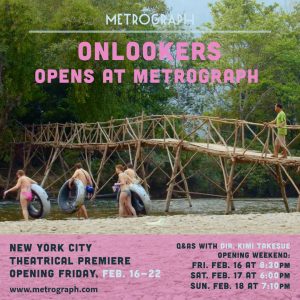
HtN: Given that the film premiered at Slamdance last year and its theatrical debut arrives more than a year later, how has your relationship with Onlookers changed in that time? You’ve screened it at many festivals with many different audiences and, obviously, there have been different experiences as you’ve traveled to various places to present the film. Where are you today relative to where you were a year ago or even while you were making it?
KT: I think there is always a lot of fear in the sense of wondering if a film will have a life. It is easy for work to fall through the cracks, especially this kind of really quiet, intimate work. This is a film that requires focus and concentration and it certainly was made to be immersive. It is a much better experience to see it in a theater than to watch it on a laptop. Even though Onlookers is speaking to the lack of attention in our culture, that is the reality. Most people will actually be watching this film on a laptop or television while multitasking and checking their email. It doesn’t work for this film. I think, ultimately, there is a fear that a film like this will get completely lost and just not go anywhere. With Onlookers, it has been wonderful. I think that the festival landscape is more competitive and I think you are competing with even more with commercial work in the festival-space. It used to be more separate.
These festivals have contracted and they’re showing a lot of work that is going to stream the following week on some service. How do you compete with that? That is why I have so much respect for Slamdance. It was one of the reasons that I wanted to reconnect and return to that kind of energy. Having a respect for spaces that really champion independent filmmaking. There are few places that exists like that. I was so pleased that it got into Slamdance but then it screened at these other remarkable places. Milestones like Cinéma du Réel at the Centre Pompidou. That was a life-achievement! It has gone all over the world. It has been amazing to show Onlookers to a wide range of audiences. While I hope that it is unique and challenging to a certain degree to viewers, the film really only demands curiosity and patience. I am really interested in making films that are accessible, where there are many different entry-points for people and that the understanding of the film isn’t elusive. I was just at a festival right outside of Paris last week and it was going full-circle in terms of an audience. This festival [Si loin, si proche], at the amazing contemporary arts space La Ferme du Buisson, focuses on cinema from Cambodia, Laos and Vietnam [or, in their own description, “aux rythmes des créations cambodgiennes, laotiennes et vietnamiennes”]. As a culturally-focused festival, it is a very unique. There was real range of different kinds of films and mine was much more arty-ish and experimental compared to the other works that they were showing. There was a young Laotian filmmaker there and he raised his hand during the Q&A. He said, “You know, I don’t usually like documentary films. When I saw the first couple of shots of the film, I was really afraid of how I was going to get through this.” Then he said, “I don’t know how you did this film but it is amazing. You showed me something new about my country. I love this film!” That meant so much to me!
ONLOOKERS (2023); dir. Kimi Takesue [72min.]
— Jonathan Marlow [@aliasMarlow]

